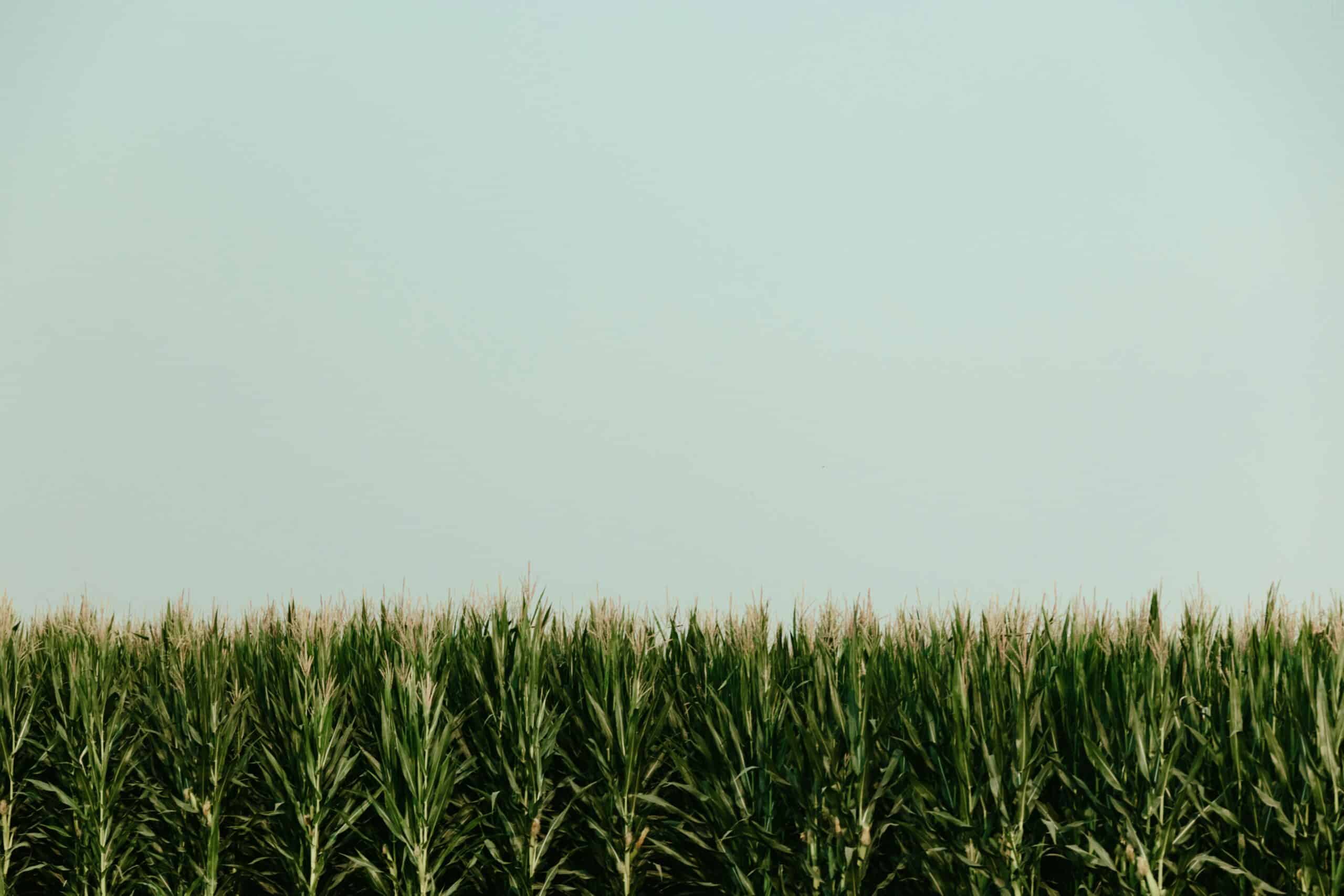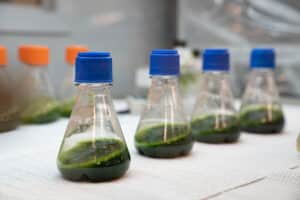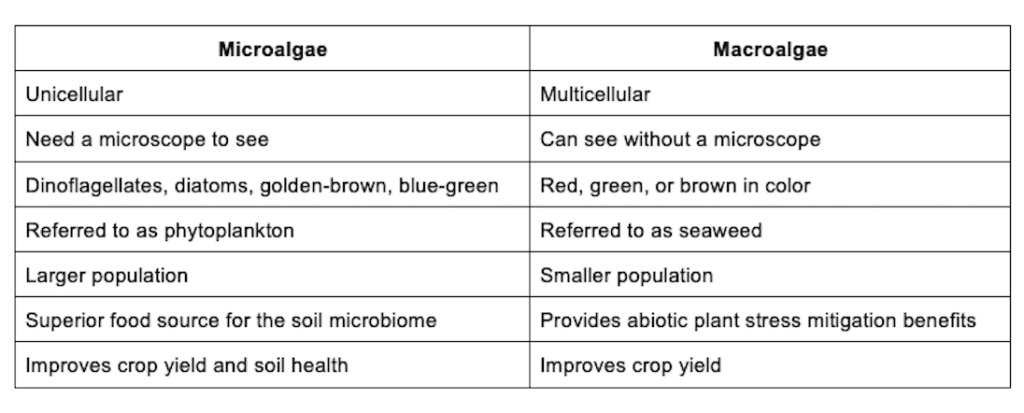Apr 11, 2025



Microalgae and macroalgae – if you were on a game show, could you tell the host the difference between these plant-like organisms? It’s likely most of us don’t know the difference between types of algae off the top of our head… unless we’re biology majors or oceanographers.
In the future, biology majors and ocean professionals will not be the only folks who know the difference between microalgae and macroalgae. Agriculture professionals will also know the differences between the two. Why?
Microalgae and macroalgae can each provide unique benefits for growers and their crops. Even though these two organisms sound similar, they offer different agricultural benefits and modes-of-action. Microalgae and macroalgae differ in size, appearance, and agricultural applications.
Both microalgae and macroalgae are types of algae. Algae are defined as “polyphyletic, photosynthetic organisms, including a diverse group of species.” They’re known as plant-like organisms that do not have true leaves, stems, or roots and are often found in the sea, freshwater, and on land.
This does not make microalgae a seaweed, like macroalgae. Instead, it’s referred to as a phytoplankton.
Algae is a very diverse plant group. Giant kelp, a type of seaweed, is one type of algae, which you may imagine swaying in a tide on the ocean floor. You’ll never see a photo of microalgae like this, as microalgae can only be seen with a microscope. Microalgae are referred to as phytoplankton and are found in soils, fresh water, and, surprisingly, the ocean.
Regardless of size, all algae are important to life on Earth. Algae take in CO2 and release O2 for us to breathe. About 70% of the oxygen in the atmosphere comes from algae.
Algae is incredibly sustainable and can be harvested daily, given its short life cycle. Because of its sustainability, it has the potential to be a long-term solution for fuel, food, feed, agriculture, and other products.
Microalgae and macroalgae have a handful of similarities. Both types of algae can be found in different habitats across the world, are photosynthetic organisms, and have opportunities to be used in agriculture. As we mentioned, they are also both part of the algae family.
When it comes to regeneration, consistency, and size, the two greatly differ.
“Micro” means small, which can be a good visual indicator of the difference between the two algae.
Microalgae is a single-celled algae. It converts sunlight, water, and carbon dioxide into biomass. They live in soil, fresh water, and saltwater. They’re considered the origin of plant life, the base of the food web, and are broadly classified by their color: blue-green, golden-brown, and green. This single-celled organism sometimes forms colonies by grouping cells together. There’s many more species of microalgae than macroalgae.
The majority of microalgae can be classified as photosynthetic eukaryotic microorganisms or prokaryotic cyanobacteria, some of which some are capable of fixing nitrogen. They can duplicate in 24 hours or less, and are one of the most abundant, untapped renewable resources on our planet. New innovative technology utilizes microalgae as a sustainable, regenerative agriculture input. Products like PhycoTerra are a beneficial microbial food source to improve crop yield and soil health.
Microalgae also have the potential to play a major role in climate change mitigation through their carbon fixation. Additionally, they produce a large amount of oxygen for the atmosphere, making it an incredibly important life form on our planet.
“Macro” means large. Macroalgae are multicellular algae, typically found in the ocean. They are more commonly known as kelp or seaweed and can be seen by the naked eye. Macroalgae naturally filter and reduce nitrites/nitrates and phosphate levels in water. Seaweed can be described as red, green, and brown in color.

Macroalgae have a long list of health benefits for humans, are potential biofuels, and have been found beneficial in other industries. Currently, macroalgae are utilized by growers as a plant biostimulant to help mitigate abiotic plant stressors such as heat stress.
However, the mode-of-action of macroalgae is different than that of microalgae, as microalgae offer regenerative and soil health benefits by providing a superior food source to feed the native microbes in the soil.

There’s estimated thousands to hundred of thousands of different species of microalgae. The two main types are dinoflagellates and diatoms. Both belong to the class of phytoplankton and require sunlight to live and grow.
Dinoflagellates grow slower than diatoms and have flagella (i.e., tail-like structures) to move and a shell-like body covering.
Diatoms also have a shell-like body covering. However, their outer covering is made of a different substance and have a rigid body.
Both types of microalgae are able to be mass produced, harvested, and generated consistently.
While macroalgae and microalgae each have their place in supporting crop health and yield, microalgae provide a unique mode-of-action benefiting soil health.
Innovative soil microbial food, like PhycoTerra, harnesses microalgal technology to feed the beneficial microbes in farm soil to support plant stand, growth, and yield, as well as overall soil health. This soil microbial food wakes up starving, dormant soil microbes and puts them to work for you.
Around 75% of soil microbes in farm soils are dormant due to starvation. If your soil microbes are dormant, they aren’t providing your soil or crops with any of the benefits they provide when awake. Waking them up is as easy as feeding them a nutrient-dense meal, like PhycoTerra.
Once awake, soil microbes help to create healthy soil, allow your natural and synthetic fertilizer to go further, improve drought tolerance, break down crop residue, and can improve yields. Applying our microalgae formula to farm soil has proven benefits for a wide range of crops like corn, soybeans, winter wheat, spring wheat, almonds, and more.
To start supporting your soil microbiome, work with a crop adviser to conduct a soil test and get a better understanding of the microbial diversity, activity, and volume of soil microbes in your soil. Then, make a plan to wake them and support their health with a microalgae superfood, like PhycoTerra.
The sooner the better. Don’t wait to get the benefits a healthy soil microbiome can provide your farm. Start a conversation to learn how PhycoTerra can support your crop yields and soil health.